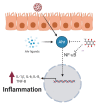Sea Urchin Pigments: Echinochrome A and Its Potential Implication in the Cytokine Storm Syndrome
- PMID: 34064550
- PMCID: PMC8151293
- DOI: 10.3390/md19050267
Sea Urchin Pigments: Echinochrome A and Its Potential Implication in the Cytokine Storm Syndrome
Abstract
Background: Echinochrome A (EchA) is a pigment from sea urchins. EchA is a polyhydroxylated 1,4-naphthoquinone that contains several hydroxyl groups appropriate for free-radical scavenging and preventing redox imbalance. EchA is the most studied molecule of this family and is an active principle approved to be used in humans, usually for cardiopathies and glaucoma. EchA is used as a pharmaceutical drug. Methods: A comprehensive literature and patent search review was undertaken using PubMed, as well as Google Scholar and Espacenet search engines to review these areas. Conclusions: In the bloodstream, EchA can mediate cellular responses, act as a radical scavenger, and activate the glutathione pathway. It decreases ROS imbalance, prevents and limits lipid peroxidation, and enhances mitochondrial functions. Most importantly, EchA contributes to the modulation of the immune system. EchA can regulate the generation of regulatory T cells, inhibit pro-inflammatory IL-1β and IL-6 cytokine production, while slightly reducing IL-8, TNF-α, INF-α, and NKT, thus correcting immune imbalance. These characteristics suggest that EchA is a candidate drug to alleviate the cytokine storm syndrome (CSS).
Keywords: cytokine storm syndrome; natural products; pigments; sea urchin; spinochromes.
Conflict of interest statement
The authors declare no conflict of interest.
Figures




References
-
- Soliman A.M., Mohamed A.S., Marie M.-A.S. Echinochrome pigment attenuates diabetic nephropathy in the models of type 1 and type 2 diabetes. Diabetes Mellit. 2016;19:464–470. doi: 10.14341/DM8039. - DOI
-
- Yoon C.S., Kim H.K., Mishchenko N.P., Vasileva E.A., Fedoreyev S.A., Shestak O.P., Balaneva N.N., Novikov V.L., Stonik V.A., Han J. The protective effects of echinochrome A structural analog against oxidative stress and doxorubicin in AC16 cardiomyocytes. Mol. Cell. Toxicol. 2019;15:407–414. doi: 10.1007/s13273-019-0044-6. - DOI
-
- Shikov A.N., Pozharitskaya O.N., Krishtopina A.S., Makarov V.G. Naphthoquinone pigments from sea urchins: Chemistry and pharmacology. Phytochem. Rev. 2018;17:509–534. doi: 10.1007/s11101-018-9547-3. - DOI
Publication types
MeSH terms
Substances
LinkOut - more resources
Full Text Sources
Medical
Miscellaneous

